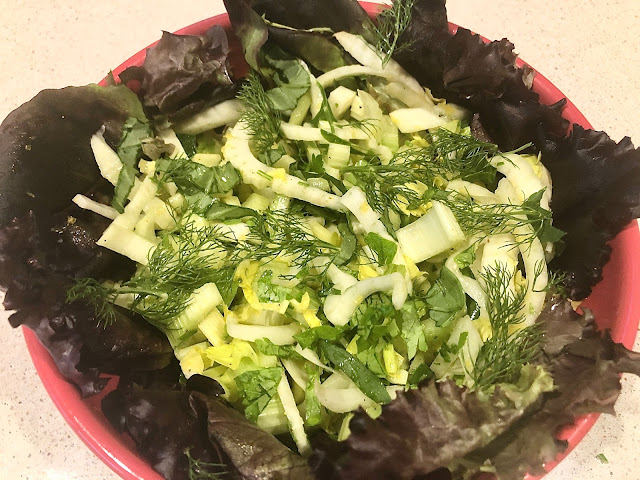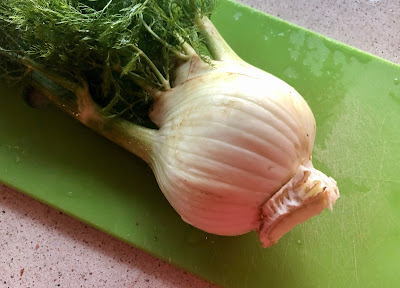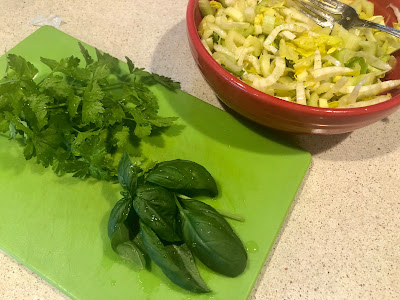
Recipe: Fennel pairs with celery hearts for a crunchy side dish
 |
|
Dressed and ready to serve, this salad is crunchy and flavorful. (Photos: Kathy
Morrison)
|
The fennel had to go, there was no question. I had plopped it into a corner of a raised bed last fall when I changed plots at my community garden. But now it was HUGE -- not to mention in the way of the spot where I wanted to put my Sweet Chelsea cherry tomato. And everything I've read says fennel is an anti-companion plant to tomatoes.
So the Giant Fennel of Carmichael was pulled up, and some of it went into a delicious salad. We had it alongside chicken, but it would be absolutely perfect with grilled salmon, if you're so inclined.
Note: As with any salad, the ingredients can be varied to one's taste. The New York Times recipe this is generally based on included radishes, radicchio and slivers of Parmesan, all of which I chose to omit for various reasons. I used about half the dressing, so there would be plenty if you decide to double the salad ingredients.
 |
|
This is the fennel I used in the salad. It was less than one-third
the entire plant I pulled out.
|
Fennel-celery salad with lemon and herbs
Serves 2-4
Ingredients:
Dressing:
3 tablespoons fresh lemon juice plus 1 teaspoon lemon zest (from 1 or 2 lemons)
1 or 2 garlic cloves, smashed but left mostly intact
Freshly ground pepper
Kosher salt
1/4 cup extra virgin olive oil
Salad:
1 medium fennel bulb, trimmed and thinly sliced (save some of the most tender fronds for garnish)
1 celery heart, inner stalks and leaves, thinly sliced (at least 1 cup)
Handful of snow pea pods, optional, halved
1 to 2 tablespoons fresh parsley, chopped
Several basil leaves, thinly sliced
Baby greens, all one kind or a mix, for serving
Garnish:
Reserved tender fronds from the fennel
 |
|
The parsley came from my garden, the basil from a plant I just
bought a few days ago. (It won't miss those leaves.)
|
Instructions:
Put the lemon juice, zest and garlic clove(s) in a jar or small bowl. Add a pinch of salt and pepper, then whisk in the olive oil (a small fork works great for this in a jar). Set dressing aside for at least 10 minutes.
To make the salad, put the sliced fennel, celery and snow peas (if using) in a salad bowl. Season lightly with salt and pepper.
Remove the garlic from the dressing, and whisk the dressing again to combine. Pour over the vegetables and toss. Sprinkle the parsley and the basil over the vegetables, stir in, and taste, then adjust the seasonings.
Line the edge of the bowl with the baby greens. Sprinkle the fennel fronds over the salad and serve.
Comments
0 comments have been posted.Sacramento Digs Gardening to your inbox.
Food in My Back Yard Series
May 6: Maintain soil moisture with mulch for garden success
April 29: What's (already) wrong with my tomato plants?
April 22: Should you stock up on fertilizer? (Yes!)
April 15: Grow culinary herbs in containers
April 8: When to plant summer vegetables
April 1: Don't be fooled by these garden myths
March 25: Fertilizer tips: How to 'feed' your vegetables for healthy growth
March 18: Time to give vegetable seedlings some more space
March 11: Ways to win the fight against weeds
March 4: Potatoes from the garden
Feb. 25: Plant a fruit tree now -- for later
Feb. 18: How to squeeze more food into less space
Feb. 11: When to plant? Consider staggering your transplants
Feb. 4: Starting in seed starting
Sites We Like
Garden Checklist for week of May 4
Enjoy this spring weather – and get gardening!
* Plant, plant, plant! It’s prime planting season in the Sacramento area. Time to set out those tomato transplants along with peppers and eggplants. Pinch off any flowers on new transplants to make them concentrate on establishing roots instead of setting premature fruit.
* Direct-seed melons, cucumbers, summer squash, corn, radishes, pumpkins and annual herbs such as basil.
* Harvest cabbage, lettuce, peas and green onions.
* In the flower garden, direct-seed sunflowers, cosmos, salvia, zinnias, marigolds, celosia and asters. (You also can transplant seedlings for many of the same flowers.)
* Plant dahlia tubers. Other perennials to set out include verbena, coreopsis, coneflower and astilbe.
* Transplant petunias, marigolds and perennial flowers such as astilbe, columbine, coneflowers, coreopsis, dahlias, rudbeckia and verbena.
* Keep an eye out for slugs, snails, earwigs and aphids that want to dine on tender new growth.
* Feed summer bloomers with a balanced fertilizer.
* For continued bloom, cut off spent flowers on roses as well as other flowering plants.
* Add mulch to the garden to maintain moisture. Mulch also cuts down on weeds. But don’t let it mound around the stems or trunks of trees or shrubs. Leave about a 6-inch to 1-foot circle to avoid crown rot or other problems.